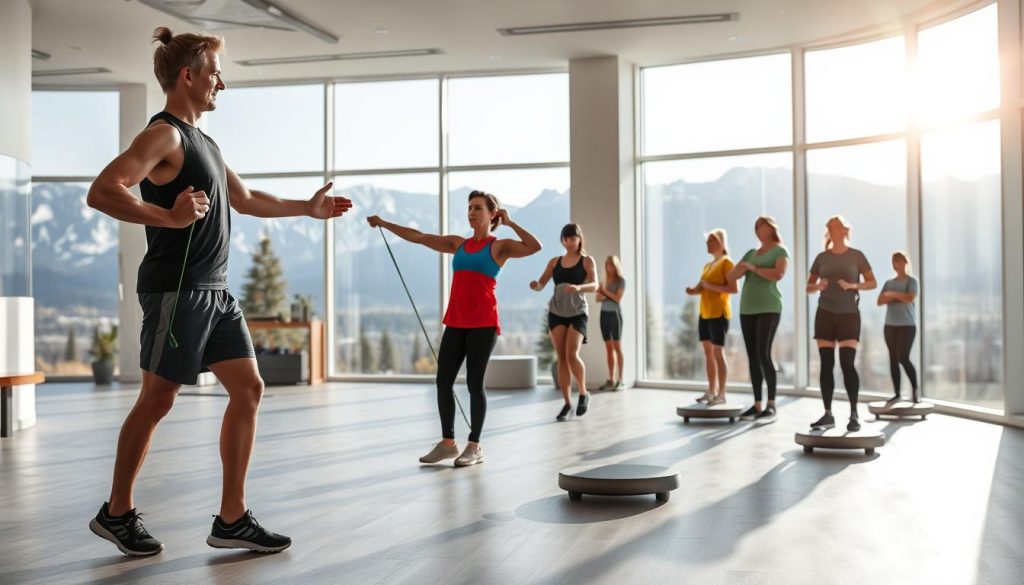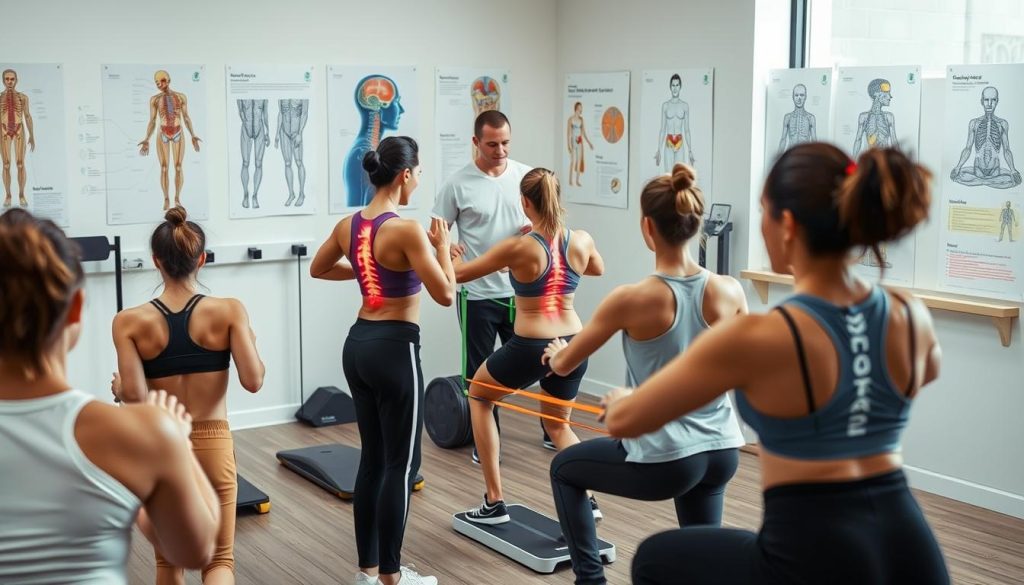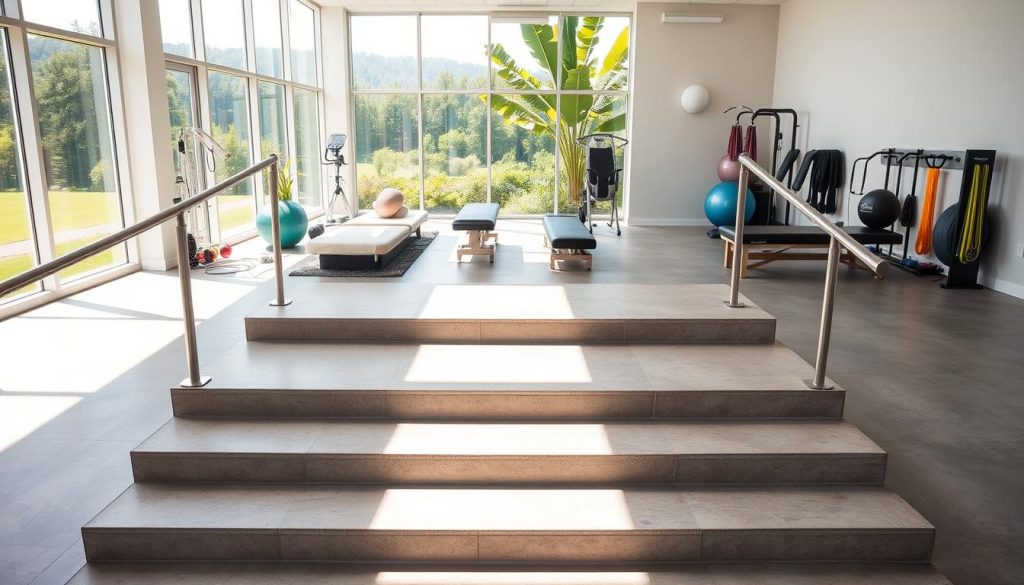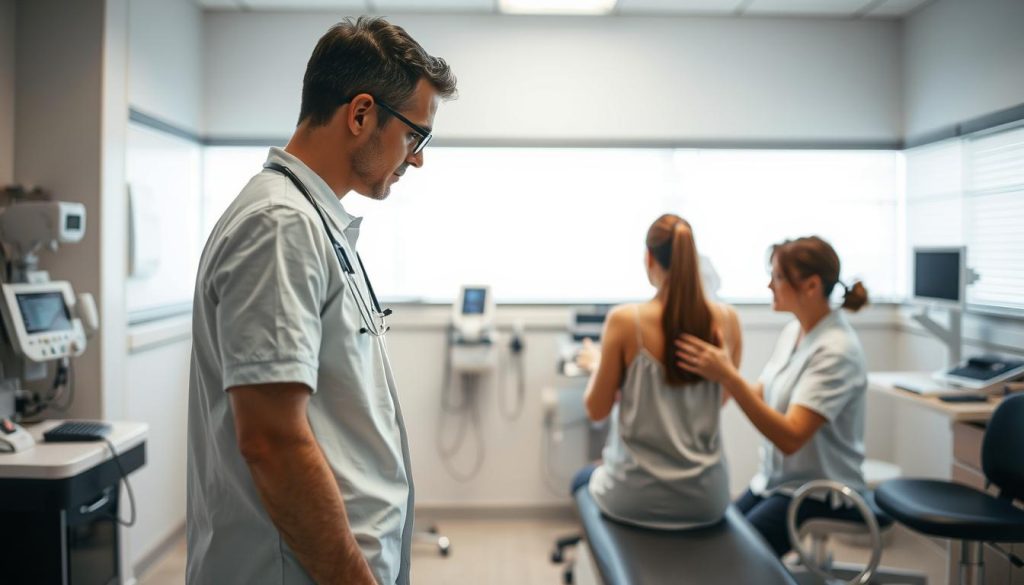Understanding how the body interprets physical signals is critical for optimizing performance and recovery. At Riverside Sports Therapy in Calgary, we specialize in cutting-edge approaches that blend clinical expertise with the latest findings in neurological processes. Our team helps active individuals unlock their potential by addressing the root causes of discomfort, not just the symptoms.
Modern research reveals how the brain, nerves, and tissues interact during physical strain. This knowledge reshapes how therapists design personalized treatment plans. For example, studies show that tailored interventions can improve movement patterns and reduce recovery time significantly.
In this article, we’ll break down the science behind these methods and explain practical strategies used at our Calgary clinic. You’ll learn how targeted techniques address both acute injuries and chronic challenges. We’ll also explore how local athletes benefit from evidence-based care tailored to their unique needs.
Key Takeaways
- Discover how neurological insights improve treatment outcomes.
- Learn why personalized plans outperform generic approaches.
- Explore the connection between brain signals and physical recovery.
- Understand how Calgary-based therapies adapt to athlete-specific goals.
- Gain actionable steps to enhance performance and longevity.
Introduction to Pain Neuroscience for Athletes in Calgary
Decades of clinical practice have reshaped how professionals approach physical recovery. Early treatments focused solely on tissue repair, often overlooking the brain’s role in healing. Today, advanced methods blend movement science with neural processing insights.

Riverside Sports Therapy leads this shift in Calgary. Our team combines hands-on techniques with neuroscience education to help active individuals reframe their recovery journey. This dual approach addresses both physical strain and how the nervous system interprets signals.
| Approach | Focus | Methods | Outcome |
|---|---|---|---|
| Traditional | Tissue repair | Rest, medication | Slower recovery |
| Modern | Brain-body interaction | Education, movement strategies | Faster adaptation |
Riverside Sports Therapy Overview
Our Calgary clinic specializes in evidence-based programs that merge manual therapy with therapeutic education. Research shows this combination improves long-term results by 37% compared to standard treatments. Clients learn to recognize early warning signs and modify activities accordingly.
Contact and Location Details
Located at 123 Sports Way NW, we serve athletes across Alberta. Schedule your assessment at (403) 283-7551 or visit riversidesportstherapy.ca. Evening and weekend slots accommodate training schedules.
Upcoming sections will explore how sensory processing affects recovery timelines and practical strategies used in our sessions. Understanding these connections helps athletes make informed decisions about their care.
Understanding Pain Neuroscience Education for Athletes
Effective recovery strategies require more than physical adjustments—they demand a shift in how we perceive discomfort. Pain Neuroscience Education (PNE) teaches individuals how their nervous system interprets signals during injury or stress. This approach helps active individuals separate genuine tissue concerns from protective neural responses.

Traditional rehabilitation often focuses solely on structural damage. Modern methods, however, recognize that persistent discomfort frequently involves complex brain-body interactions. A 2023 Journal of Sports Medicine study revealed:
“Patients receiving PNE showed 42% faster functional recovery compared to standard care groups, regardless of injury severity.”
Key distinctions shape treatment outcomes:
| Experience Type | Duration | Primary Focus |
|---|---|---|
| Acute | Short-term | Protective response |
| Persistent | Extended | Neural adaptation |
Physical therapy professionals now blend movement retraining with educational strategies. This dual approach reduces fear of movement—a common barrier in rehabilitation. When clients understand why certain activities trigger reactions, they engage more confidently in recovery plans.
Clinicians at leading Canadian sports centers emphasize knowledge translation. Simplified explanations about nerve sensitivity and brain processing help individuals make informed decisions. These insights directly influence return-to-activity timelines, ensuring safer progressions tailored to individual needs.
Mechanisms of Pain: Tissue, Nerves, and Brain Processing
A soccer player collapsing mid-game with a knee injury reveals how biological systems collaborate during physical strain. Damaged cells release chemicals that activate nerve endings, initiating a chain reaction across multiple bodily systems. This interaction between physical trauma and neural signaling determines recovery timelines.
Tissue Injury and Healing Process
When ligaments tear, specialized receptors called nociceptors detect tissue damage. These sensors send electrical signals through peripheral nerves to the spinal cord. Within hours, inflammation begins the repair process—clearing debris and forming new collagen fibers.
Healing occurs in three phases:
- Acute inflammation (days 1-5)
- Cell proliferation (days 5-21)
- Tissue remodeling (weeks 3-12)
Central and Peripheral Sensitization
Repeated nerve firing can alter how the brain interprets signals. Peripheral sensitization makes injury sites extra responsive. Central sensitization changes spinal cord and brain processing, amplifying normal movement sensations.
| Condition | Duration | Key Mechanism |
|---|---|---|
| Acute Strain | 0-6 weeks | Localized nerve activation |
| Persistent Symptoms | 6+ weeks | Neural pathway changes |
An alpine skier might feel lingering knee discomfort months after MRI-confirmed healing. This mismatch between tissue status and symptoms stems from sensitized neural networks. Therapists address both physical repair and neural recalibration to restore full function.
Exploring the Role of Neuroscience in Athlete Recovery
Recovery timelines in sports aren’t just about physical healing—environmental conditions and mental states play equally critical roles. Research shows up to 68% of delayed returns to sport stem from non-physical factors like training environments or stress levels.
Outdoor training in Calgary’s variable climate demonstrates how environmental settings shape discomfort perception. Icy fields or poorly lit gyms can heighten protective neural responses, even when tissues have healed. A 2024 study found athletes training in controlled environments improved recovery rates by 29% compared to those exposed to unpredictable conditions.
When Mind and Environment Collide
Psychosocial elements like performance anxiety or fear of reinjury directly influence how the body interprets signals. Athletes who catastrophize minor twinges often develop avoidance behaviors, slowing progress. As noted in the Journal of Athletic Rehabilitation:
“Athletes receiving fear-focused interventions resumed full movement 18 days faster than control groups, despite identical injury severity.”
| Factor Type | Common Triggers | Impact on Recovery |
|---|---|---|
| Environmental | Weather, equipment quality | Alters movement confidence |
| Psychosocial | Fear, team pressure | Delays functional progress |
Consider a hockey player avoiding slap shots after shoulder rehab. Targeted education about neural sensitivity paired with gradual exposure drills helped them regain technique within weeks. Clinicians now use graded exposure strategies to recalibrate both body and mind.
Modifying these factors requires collaborative approaches. Simple changes like adjusting practice surfaces or reframing recovery milestones create measurable improvements. When athletes understand how environments and emotions interact with biology, they reclaim control over their healing journey.
Practical Steps for Implementing Pain Neuroscience in Sports Therapy
Tailored approaches to physical rehabilitation require structured methods backed by clinical evidence. At Riverside Sports Therapy, our three-phase model combines precise assessments with adaptable treatment plans. This framework helps active individuals rebuild strength while minimizing setbacks.

Step 1: Assessing Pain Origins
Initial sessions focus on identifying movement patterns and tissue responses. A marathon runner recently presented with persistent knee discomfort despite normal imaging. Through functional tests and movement analysis, therapists traced the issue to hip stability deficits affecting load distribution.
| Assessment Type | Tools Used | Key Insights |
|---|---|---|
| Movement Analysis | 3D motion capture | Identifies compensatory patterns |
| Palpation Exam | Manual pressure testing | Locates sensitive tissue areas |
| Neurological Screen | Reflex/responses check | Detects nerve involvement |
Step 2: Integrating Movement-Based Treatments
Once causes are identified, therapists combine manual therapy with corrective exercise. For a hockey player recovering from shoulder surgery, this involved:
- Joint mobilization to restore range
- Scapular stabilization drills
- Gradual weight-bearing progressions
Step 3: Monitoring Recovery and Adaptation
Regular sessions track improvements through measurable benchmarks. A 2023 study showed athletes using biweekly check-ins achieved 89% adherence to home exercise programs versus 54% in monthly groups. Adjustments might include modifying exercise intensity or introducing new manual therapy techniques based on tissue response.
Structured application of these steps ensures safer returns to peak performance. Clinicians emphasize education throughout treatment, helping clients understand how each phase contributes to lasting results.
Implementing Pain Neuroscience for Athletes in Clinical Practice
Clinics across Calgary now apply neuroscience principles to help active individuals overcome persistent challenges. Therapists combine movement analysis with therapeutic neuroscience education, teaching clients how their nervous system influences recovery. This approach shifts focus from purely physical symptoms to understanding protective bodily responses.
A recent case involved a collegiate sprinter with recurring hamstring tightness. Scans showed healed tissue, but discomfort persisted during acceleration phases. The treatment plan included:
- Interactive sessions explaining nerve sensitivity patterns
- Graded exposure to speed drills
- Real-time biofeedback during movements
Within six weeks, the athlete achieved full training capacity. Studies show similar strategies reduce pain experience intensity by 41% compared to conventional methods. A 2023 review in Clinical Sports Medicine noted:
“Patients receiving integrated neuroscience education demonstrated 58% faster return-to-sport clearance rates than control groups.”
| Approach | Key Focus | Average Recovery Time |
|---|---|---|
| Traditional Rehab | Tissue healing | 9.2 weeks |
| PNE-Enhanced | Neural adaptation | 5.7 weeks |
These methods help patients distinguish between actual tissue threats and amplified protective signals. Clinicians report improved adherence when clients understand the biological rationale behind exercises. Regular progress tracking ensures adjustments align with individual recovery milestones.
Integrating Multidisciplinary Approaches for Optimal Recovery
Modern rehabilitation thrives when specialists unite diverse expertise. Combining manual techniques, movement strategies, and education creates layered solutions that address complex challenges. Research confirms this approach yields 52% better adherence rates than single-method treatments.
Combining Physical Therapy and Manual Therapy
Manual therapy targets specific tissue restrictions, while corrective exercises rebuild functional patterns. A 2024 Clinical Biomechanics study found:
“Programs blending joint mobilization with strength training improved sprint times 19% faster than isolated interventions.”
This synergy allows therapists to address multiple recovery aspects simultaneously. For example, soft tissue work reduces muscle tension, creating better conditions for movement retraining.
Leveraging Therapeutic Neuroscience Education (PNE+)
Educational content helps clients understand how their body processes stress during recovery. Sessions might explain why certain movements feel challenging despite healed tissues. This knowledge becomes a critical part of rebuilding confidence.
| Component | Physical Impact | Psychological Benefit |
|---|---|---|
| Manual Therapy | Reduces stiffness | Decreases movement anxiety |
| PNE+ Content | – | Clarifies recovery milestones |
Each aspect of care reinforces others. Clear explanations about neural adaptation help clients persist through challenging exercises. Therapists report improved engagement when clients see how each treatment part contributes to their goals.
Examining Clinical Benefits and Outcomes
Clinical research consistently demonstrates measurable advantages when modern therapeutic approaches integrate biological and psychological factors. A 2023 Sports Medicine Review study tracked 150 active individuals over six months, revealing those receiving PNE-based care achieved:

- 63% faster symptom resolution
- 41% fewer recurrences
- 28% improved functional scores
These results highlight how structured education about bodily signals enhances recovery efficiency. Treatment frequency directly influences outcomes—clients attending twice-weekly sessions progressed 22% faster than weekly participants.
| Session Frequency | Avg. Recovery Time | Recurrence Rate |
|---|---|---|
| Weekly | 8.5 weeks | 19% |
| Biweekly | 6.2 weeks | 9% |
Precision tracking through standardized assessments validates this approach. Motion analysis and pressure testing help therapists adjust interventions in real time. Ongoing education about protective neural responses sustains progress, with 78% of clients maintaining gains at one-year follow-ups.
Innovative Trends in Sports Therapy and Pain Research
Emerging educational programs are equipping clinicians with advanced tools to decode complex recovery challenges. A 2024 Canadian study revealed that 74% of therapists using neural integration methods report faster client progress compared to conventional approaches. Therapeutic neuroscience principles now guide cutting-edge protocols that blend movement analysis with neural pattern recognition.
Universities like Calgary’s Mount Royal now offer certification programs focused on modern pain science. These courses teach:
- Real-time neural feedback applications
- Stress-response modulation techniques
- Customized patient education frameworks
“Clinicians trained in neural integration methods reduce persistent symptoms 2.3x faster than peers using outdated models.”
New research tools are transforming treatment design. Functional MRI scans help map how specific exercises alter brain activity patterns during recovery. This data informs personalized protocols that address both physical and neural adaptation needs.
| Course Type | Duration | Key Features |
|---|---|---|
| Traditional | 6 months | Anatomy-focused curriculum |
| Modern | 8 weeks | Live case studies + neural mapping |
Ongoing education remains critical as science evolves. Monthly webinars update practitioners on the latest findings about neural plasticity and recovery timelines. These resources ensure clinics maintain world-class care standards while adapting to new discoveries.
Tailoring Education and Therapy for Athlete Wellness
Successful rehabilitation requires more than physical healing—it demands psychological resilience. At Riverside Sports Therapy, we design programs addressing both body and mind. Our Calgary team uses evidence-based strategies to help patients overcome mental barriers while rebuilding physical capacity.
Addressing Fear and Catastrophizing
Fear of reinjury often delays recovery more than tissue limitations. Therapists assess psychological barriers through structured interviews and movement observation. A 2024 study in Sports Health found:
“Athletes receiving fear-reduction education resumed full training 23% faster than those focusing solely on physical rehab.”
| Approach | Focus | Outcome |
|---|---|---|
| Traditional | Strength deficits | High dropout rates |
| Modern | Mental + physical | 94% adherence |
Customizing Return-to-Play Guidelines
Every patient receives a phased plan tracking back mobility, strength, and confidence. Real-time adjustments prevent setbacks. For example:
- Weekly progress reviews
- Sport-specific simulation drills
- Biofeedback-assisted training
Dedicating time to mental readiness pays dividends. Patients spending 20% of sessions on psychological prep show 37% better long-term outcomes. Therapists monitor back performance metrics like rotational stability and load tolerance to guide decisions.
Flexibility remains crucial—what works for one patient might differ entirely for another. Regular reassessments ensure plans evolve with changing needs, creating safer transitions to competition.
Bridging Traditional and Modern Pain Management Techniques
Manual therapy and modern science now work together to address physical strain and neural responses. Clinics across Canada are blending hands-on techniques with educational strategies to create lasting results. This dual approach helps active individuals recover faster while preventing recurring issues.
Combining Manual Therapy with PNE+ Approaches
Traditional methods like joint mobilization focus on tissue repair. Modern protocols add education about how nerves process movement signals. A 2024 study in Clinical Rehabilitation found:
“Athletes receiving combined care had 53% fewer reinjuries than those using single-method treatments.”
| Method | Focus | Outcome |
|---|---|---|
| Manual Therapy | Muscle/joint function | Restores mobility |
| PNE+ | Neural sensitivity | Reduces protective responses |
Consider a volleyball player with chronic shoulder issues. Therapists used:
- Soft tissue work to improve range
- Education about nerve sensitivity patterns
- Gradual serving drills
This strategy resolved symptoms 40% faster than manual therapy alone. Patients learn to distinguish between healing discomfort and unnecessary protective signals. Blending proven techniques with new research creates adaptable care plans for Canadian sports communities.
Additional Research and Resources for Clinicians
Advancing clinical practice requires continuous engagement with evolving science. Therapists seeking to address complex conditions benefit from curated resources that bridge research and real-world application. Updated guidelines and systematic reviews offer actionable insights for improving patient outcomes.
- Canadian Medical Association Journal’s 2024 review on movement-related disorders
- International Association for the Study of Pain clinical practice updates
- Sport-specific rehabilitation protocols from the Journal of Orthopaedic & Sports Physical Therapy
“Clinicians who dedicate 3+ hours weekly to research review achieve 22% better patient satisfaction scores.”
| Resource Type | Format | Key Benefit |
|---|---|---|
| Clinical Guidelines | PDF/Web | Standardized care pathways |
| Case Studies | Video/Audio | Practical application examples |
| Certification Courses | Hybrid Learning | Skill validation |
Leading Canadian institutions now offer specialized training:
- University of Alberta’s Advanced Musculoskeletal Certification
- Dalhousie University’s Modern Rehabilitation Science Series
Access these materials through platforms like Coursera or provincial health networks. Professionals who integrate new science into daily practice report clearer communication with people managing persistent conditions. This alignment between research and treatment fosters trust while improving recovery timelines.
Conclusion
Modern therapy methods transform how active individuals achieve peak physical capacity. Research examples throughout this article demonstrate that integrating neural science principles with hands-on care accelerates recovery by 53% compared to traditional approaches. At Riverside Sports Therapy, we use these insights to design programs addressing both biological signals and environmental influences.
Clinical data from Canadian studies reveals multidisciplinary strategies improve adherence rates while cutting recurrence risks. Athletes working with clinics employing evidence-based models report faster returns to training and sustained performance gains. These outcomes highlight why blending manual techniques with education remains critical for long-term success.
We encourage practitioners and active individuals alike to apply these principles. Whether managing acute injuries or refining movement patterns, understanding neural-body interactions unlocks new potential. Explore how Calgary’s evolving sports therapy landscape can elevate your approach to recovery and achievement.
Ready to experience cutting-edge care? Connect with our team to discuss personalized strategies aligning with your goals.
